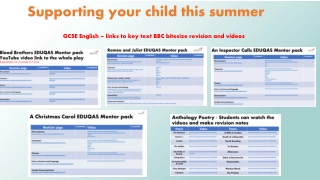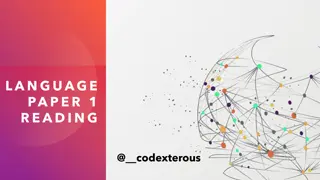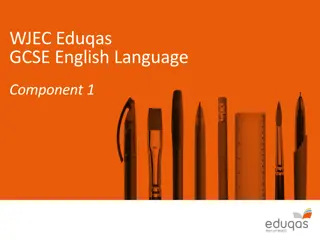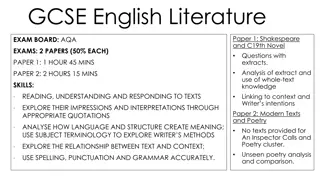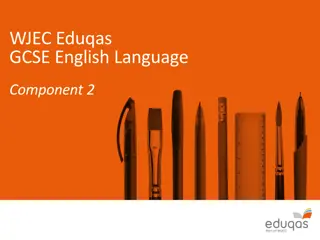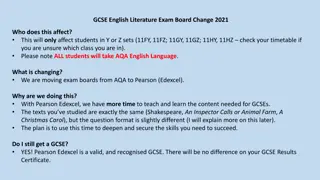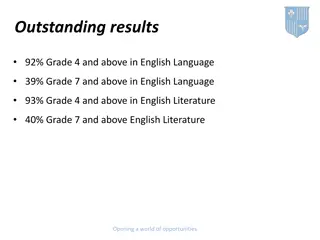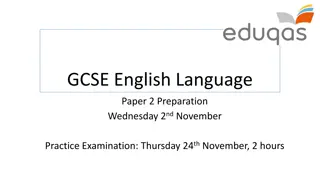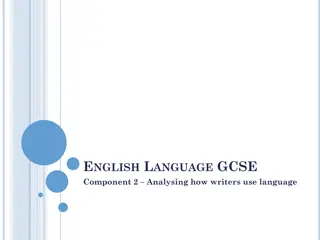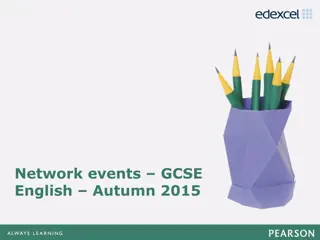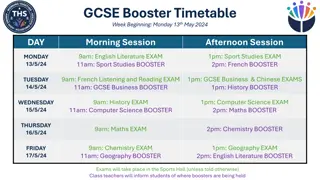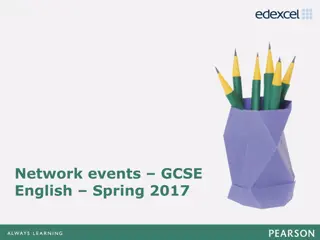Resilience in GCSE English Language Preparation
In this lesson, students delve into GCSE English language questions focusing on character analysis, literary elements, and critical thinking skills. The lesson covers topics such as identifying adverbs, analyzing Macbeth's fatal flaw, exploring synonyms, and engaging with a novel excerpt by Jack London set in a post-apocalyptic world. Students are guided through warm-up questions and detailed analysis tasks to enhance comprehension and writing abilities, with a special emphasis on building resilience in tackling challenging academic tasks.
Download Presentation

Please find below an Image/Link to download the presentation.
The content on the website is provided AS IS for your information and personal use only. It may not be sold, licensed, or shared on other websites without obtaining consent from the author.If you encounter any issues during the download, it is possible that the publisher has removed the file from their server.
You are allowed to download the files provided on this website for personal or commercial use, subject to the condition that they are used lawfully. All files are the property of their respective owners.
The content on the website is provided AS IS for your information and personal use only. It may not be sold, licensed, or shared on other websites without obtaining consent from the author.
E N D
Presentation Transcript
+ Tuesday, 21st September 2020 English Language paper 1 Last year: What is an adverb? Last term: What is Macbeth s fatal flaw? (What characteristic leads to his downfall?) Last week: Write three synonyms for nice . This lessons Character focus: Resilience - beginning to tackle GCSE English language questions
+ Explorations in Creative Reading and Writing Revision
Read the extract Read the extract, which is taken from the opening of a novel by Jack London. It was published in 1912, but it is set in the year 2073 after A plague has wiped out most of humanity. In this section, an old man and a boy are travelling through a forest.
Warm up Question 1 (5minutes) The first two paragraphs Q1. [AO1] Read again the first part of the source, lines 1 to 8 List four things from this part of the text about the path that the old man and the boy were walking along. [4 marks] 1. The path ___________________________________________________ 2. The path ____________________________________________________ 3. The path ____________________________________________________ 4. The path _________________________________________________________ Top tip: A lot of students include points that are not relevant to the question. To avoid this, you should start each sentence with the topic from the question So, in this case you could start with The path to ensure you are answering the question relevantly.
Make sure you only focus on lines 1-8
Warm up Question 1 (5minutes) Your answers might include The path leads along the embankment of an old railroad. The path is narrow as a man s body . The path is used by wild animals. The path has forest-mold on it. The path has pieces of rusty iron from the railroad showing through. There is a forest on either side of the path.
View Question 2 Guide (AO2) 10 mins Look in detail at this extract from lines 9 to 16 of the source. How does the writer use language here to describe the old man? Before you start. Look at the next slides for tips and advice. You couldinclude the writer s choice of: Words and phrases Language features and techniques Sentence forms (8 marks) Top Tips 10 minutes 2-3 PEZZ s 8 marks POINT: The writer uses the [technique] to (link to Q) EVIDENCE: Zoom in: The use of makes the reader imagine/think Zoom out: This may make the reader feel
1. Make sure you are looking at the right section on your source! 2. Draw a square around the section if you have it on paper. Lines 9-16 paragraph 3 An old man and a boy travelled along this runway. They moved slowly, for the old man was very old, a touch of palsy** made his movements tremulous, and he leaned heavily upon his staff. A rude skull-cap of goat- skin protected his head from the sun. From beneath this fell a scant fringe of stained and dirty-white hair. A visor, ingeniously made from a large leaf, shielded his eyes, and from under this he peered at the way of his feet on the trail. His beard, which should have been snow-white but which showed the same weather-wear and camp-stain as his hair, fell nearly to his waist in a great tangled mass. About his chest and shoulders hung a single, mangy garment of goat-skin. His arms and legs, withered and skinny, betokened extreme age, as well as did their sunburn and scars and scratches betoken long years of exposure to the elements. .
Question 2 Tips Tip: when writing up your answer Avoid writing generalised comments or statements: For example, do not write: Draws the reader in . Makes the reader want to read on Stops the reader getting bored Helps the reader create an image in their head To make it flow better . Some of these phrases can be made to sound pretty elaborate, but essentially they say nothing at all, because they are not specific and they fool no-one least of all the examiner!
AO2 Question2 Skills Descriptors Level + Level 4: Detailed, perceptive analysis (7- 8 marks) Shows detailed and perceptive understanding of language: Analysesthe effects of the writer s choices of language Selects a judicious range of textual detail Makes sophisticated and accurate use of subject terminology Gold Shows clear understanding of language: Explains clearly the effects of the writer s choices of language Selects a range of relevant textual detail Makes clear and accurate use of subject terminology Level 3: Clear, relevant explanation (5-6 marks) Silver Shows some understanding of language: Attempts to comment on the effect of language Selects some appropriate textual detail Makes some use of subject terminology, mainly appropriately Level 2: Some understandingand comment (3-4 marks) Bronze Shows simple awareness of language: Offers simple comment on effect of language Selects simple references or textual detail Simple use of subject terminology, not always appropriate Level 1: Simple, limited comment (1-2 marks) This is how the examiner will mark you.
Time to answer: Question 2 (AO2) 10 mins Look in detail at this extract from lines 9 to 16 of the source. How does the writer use language here to describe the old man? You couldinclude the writer s choice of: Spend 10 mins on this Question Words and phrases Language features and techniques Sentence forms (8 marks) Top Tips 10 minutes 2-3 PEZZ s 8 marks Use the PEZZ frame to support you. POINT: The writer uses the [technique] to (link to Q) EVIDENCE: Zoom in: The use of makes the reader imagine/think Zoom out: This may make the reader feel
Hint: The examiner picked out some of these language devices below as evidence to focus on. Did you use these in your PEZZ s? An old man and a boy travelled along this runway. They moved slowly, . for the old man was very old, a touch of palsy made his movements tremulous, and he leaned heavily upon his staff. A rude skull-cap of goat-skin protected his head from the sun. From beneath this fell a scant fringe of stained and dirty-white hair. A visor, ingeniously made from a large leaf, shielded his eyes, and from under this he peered at the way of his feet on the trail. His beard, which should have been snow-white but which showed the same weather-wear and camp-stain as his hair, fell nearly to his waist in a great tangled mass. About his chest and shoulders hung a single, mangy garment of goat-skin. His arms and legs, withered and skinny, betokened extreme age, as well as did their sunburn and scars and scratches betoken long years of exposure to the elements.
Activity 3: Evaluating a students response The writer has shown how vulnerable and frail the old man is. The use of the verb leaned in conjunction with the adverb heavily betrays his reliance on his walking-stick in order to move about. His movements are tremulous , or shaky, also suggesting impaired mobility in old age. Bronze: Has the student identified some interesting language features? Silver: Has the student chosen some relevant quotations. Are they are accurately set out? Adjectives used to describe his appearance ( dirty , stained mangy ), make him appear unkempt and filthy, perhaps suggesting he has been living rough for a long time away from normal, civilised society. Gold: Has the student has clearly explained the effect of the language features? The long subordinate clause in the sentence beginning, His beard also contrasts how the man s beard should have been ( snow-white ) with how it is now ( a great tangled mess ). Thinking hard: What else could the student have identified and explained?
Self Assessment: Based on these questions below. Give yourself a WWW (What Went Well a strength) and an EBI (Even Better If a target) Have you identified language techniques? Have you chosen relevant supporting quotations? Is your writing accurate and clear? Have you clearly explained the effects of the writer s choices of language? Have you made accurate use of subject terminology?
+Make a note of your strengths and weaknesses to help you focus your revision: What skills do you need to work on? Red I need more help. HELP ME! Amber- I can do it but need to work on this as it was challenging. Green I ve got this


